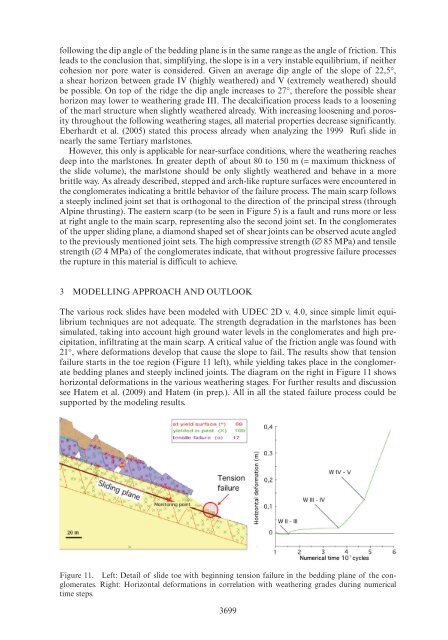The 1806 Goldau landslide event—analysis of a large rock slide
The 1806 Goldau landslide event—analysis of a large rock slide
The 1806 Goldau landslide event—analysis of a large rock slide
Create successful ePaper yourself
Turn your PDF publications into a flip-book with our unique Google optimized e-Paper software.
following the dip angle <strong>of</strong> the bedding plane is in the same range as the angle <strong>of</strong> friction. This<br />
leads to the conclusion that, simplifying, the slope is in a very instable equilibrium, if neither<br />
cohesion nor pore water is considered. Given an average dip angle <strong>of</strong> the slope <strong>of</strong> 22,5°,<br />
a shear horizon between grade IV (highly weathered) and V (extremely weathered) should<br />
be possible. On top <strong>of</strong> the ridge the dip angle increases to 27°, therefore the possible shear<br />
horizon may lower to weathering grade III. <strong>The</strong> decalcification process leads to a loosening<br />
<strong>of</strong> the marl structure when slightly weathered already. With increasing loosening and porosity<br />
throughout the following weathering stages, all material properties decrease significantly.<br />
Eberhardt et al. (2005) stated this process already when analyzing the 1999 Rufi <strong>slide</strong> in<br />
nearly the same Tertiary marlstones.<br />
However, this only is applicable for near-surface conditions, where the weathering reaches<br />
deep into the marlstones. In greater depth <strong>of</strong> about 80 to 150 m (= maximum thickness <strong>of</strong><br />
the <strong>slide</strong> volume), the marlstone should be only slightly weathered and behave in a more<br />
brittle way. As already described, stepped and arch-like rupture surfaces were encountered in<br />
the conglomerates indicating a brittle behavior <strong>of</strong> the failure process. <strong>The</strong> main scarp follows<br />
a steeply inclined joint set that is orthogonal to the direction <strong>of</strong> the principal stress (through<br />
Alpine thrusting). <strong>The</strong> eastern scarp (to be seen in Figure 5) is a fault and runs more or less<br />
at right angle to the main scarp, representing also the second joint set. In the conglomerates<br />
<strong>of</strong> the upper sliding plane, a diamond shaped set <strong>of</strong> shear joints can be observed acute angled<br />
to the previously mentioned joint sets. <strong>The</strong> high compressive strength (∅ 85 MPa) and tensile<br />
strength (∅ 4 MPa) <strong>of</strong> the conglomerates indicate, that without progressive failure processes<br />
the rupture in this material is difficult to achieve.<br />
3 MODELLING APPROACH AND OUTLOOK<br />
<strong>The</strong> various <strong>rock</strong> <strong>slide</strong>s have been modeled with UDEC 2D v. 4.0, since simple limit equilibrium<br />
techniques are not adequate. <strong>The</strong> strength degradation in the marlstones has been<br />
simulated, taking into account high ground water levels in the conglomerates and high precipitation,<br />
infiltrating at the main scarp. A critical value <strong>of</strong> the friction angle was found with<br />
21°, where deformations develop that cause the slope to fail. <strong>The</strong> results show that tension<br />
failure starts in the toe region (Figure 11 left), while yielding takes place in the conglomerate<br />
bedding planes and steeply inclined joints. <strong>The</strong> diagram on the right in Figure 11 shows<br />
horizontal deformations in the various weathering stages. For further results and discussion<br />
see Hatem et al. (2009) and Hatem (in prep.). All in all the stated failure process could be<br />
supported by the modeling results.<br />
Figure 11. Left: Detail <strong>of</strong> <strong>slide</strong> toe with beginning tension failure in the bedding plane <strong>of</strong> the conglomerates.<br />
Right: Horizontal deformations in correlation with weathering grades during numerical<br />
time steps.<br />
3699















